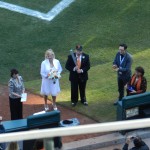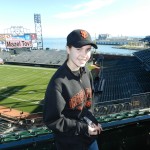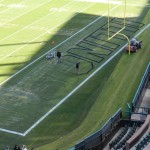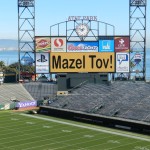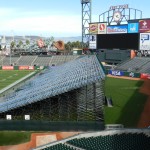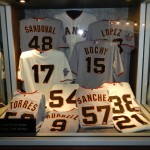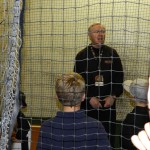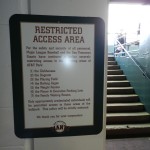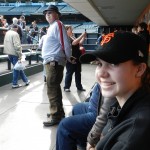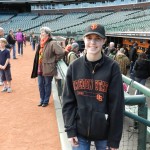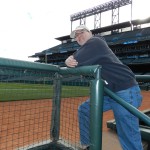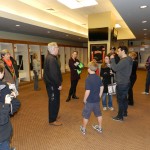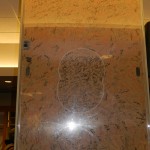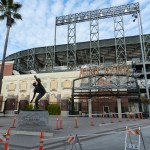![DSCN0146[1]](https://www.eastportlandblog.com/wp-content/uploads/2012/04/DSCN01461-300x225.jpg)
Our tour guide was a retired executive who preferred to spend his golden years volunteering for the Giants over playing golf. He took us first to the upper deck behind home plate, where he gave us a brief history of the ballpark and described the various art works, including the Coca-Cola bottle and 1920’s-era baseball glove behind the left-field bleachers. As he spoke, a couple stood at home plate with a small party and renewed their wedding vows as the words “MAZEL TOV” shone in bold letters above them on the scoreboard. The scene reminded me of a wedding performed before a game last spring on the pitcher’s mound by Giants announcer Mike Krukow. “Always stay with your starter,” he told the couple. “Never go to your bullpen.”
The park was set up for football, as it had been since October for the University of California Golden Bears football team, whose stadium was being renovated. A gigantic set of portable bleachers sat in right and center field, leaving just the right amount of space for the gridiron while ensuring decent views for most of the fans. Coming up that weekend was the Kraft Fight Hunger college bowl game between UCLA and Illinois. In the end zone nearest us, a couple of stadium workers spray-painted the letters ILLINOIS with the aid of a stencil. I had always wondered how crews managed to decorate grass fields with such precision.
![DSCN0139[1]](https://www.eastportlandblog.com/wp-content/uploads/2012/04/DSCN01391-300x225.jpg)
The entrance to the dugout was across the hall from the batting cage, announced by a large sign that read “RESTRICTED ACCESS AREA.” This was an attraction for visitors if there ever was one. After leading us up the steps, our guide allowed us a generously long time to explore the area around the dugout and home plate, so long as we stayed off the perfectly manicured grass. The dugout floor was pristine, free of the crushed paper cups, sunflower seeds and goodness knows what else that normally littered it during games. I dragged Jillian around and took her picture wherever I could find a good background, including in the dugout and at home plate facing the scoreboard. I gave her the camera and had her do the same for me. One picture I had her take was my version of the classic manager pose, leaning on the railing with one foot on the top step, trying to look as if I was getting ready to walk out to the mound to remove a struggling pitcher. Usually I’m too self-conscious to act out fantasies, but this was too good an opportunity to resist.
![DSCN0112[1]](https://www.eastportlandblog.com/wp-content/uploads/2012/04/DSCN01121-300x225.jpg)
When we got home that night, I immediately took the camera’s memory card and plugged it into the computer to look over the pictures we’d taken. My wife had told me before leaving to make sure I took a lot of pictures of people and not just scenery. As I viewed the results I silently thanked her for the advice. I could hardly stop looking at the pictures of Jillian. Smiling beautifully from just about every frame I’d taken of her, she was gorgeous in her Giants cap and Oregon State sweatshirt, the latter being her favorite piece of clothing. Her face seemed absolutely perfect. I wasn’t sure whether to marvel that a descendant of mine could look this good or to take it as a sign that maybe this parenting thing was going to work out after all.
Either way, it was the best part of my day.
